If you’re into jazz guitars, then you probably know that these type of guitars are big bodied, most of the time they come semi-automatic while boasting a design that enables the guitar to produce rich and warm tones.
Going back in time, jazz first was played on acoustic guitars, while before amplification, guitar sounds were often lost in the mix of a big band sound. Nowadays, with all these innovations and the introduction of archtop acoustics, guitars contain a magnetic pickup, arch tops ushered in a new era of guitar manufacturing.
In other terms, this is what allows guitar players to be heard in the way that they want to be heard. But there was a downside to this since archtop guitars have a vast hollow area inside, and that would create high levels of unwanted microphonic feedback.
This is where jazz guitar players started to use semi-acoustic guitars. What made these stand out from the other types on the market was the fact that they came with feedback reducing wooden blocks installed inside the body. This would add extra weight to the guitar.
At first, it was Gibson and Ibanez that started the mass-production in the market, and they offered a mass range of hollow-bodied guitars that were favored by jazz players as well as players of blues and rock n’ roll.
Now that you’re caught up with history, when it comes to sound, to produce jazz music, the guitar should be able to output a perfect combination and a balance of warmth and clarity. Many solid-body guitars do that by using a clean tone played through the neck pickup, however, jazz guitars that will suit jazz players more produce that particular sound without becoming overly woolly when lines are played at any speed.
In this case, I have compiled a list of Top 5 best electric guitars for jazz, where you’ll be able to find jazz guitars ranging from budget-friendly to premium, while the list was also made based on durability, sound quality, and aesthetics. So, let’s not wait any further and start with the product reviews right away.
Table of Contents
The Top 5 Guitars For Jazz
5. Fender American Elite Telecaster Thinline
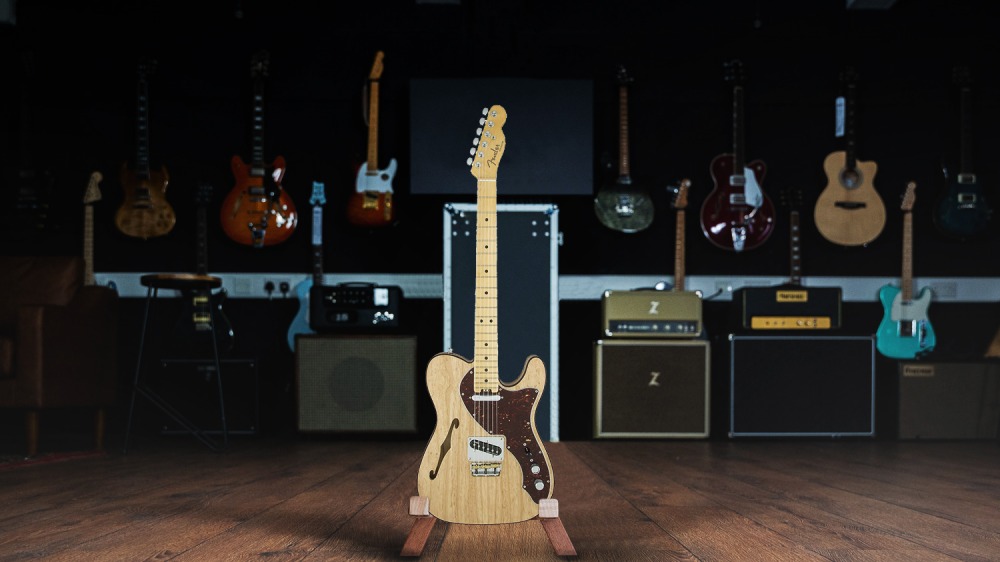
Fender is a well-known brand which has been around for quite some time now, and due to their quality jazz guitars, the company has managed to stay on top of the line for customers and players around the world.
The Fender American Elite Telecaster Thinline sports a lightweight ash body that features a semi-hollow construction and it’s followed by a satin finish maple neck. This jazz guitar has a pretty eye-catching design, while for the most part, everything else is completely modified for performance and tone.
I have used other Fender jazz guitars before, but I was glad that this model came with some unexpected improvements, starting from its perfectly carved compound “C” neck shape, and it continues to a comfortable “D” profile while climbing the neck. Other than that, the fingerboard features a 9.5 to 14-inch compound radius that basically makes fretting out nearly impossible.
To continue rounding up this jazz guitar, you’ll also like the fact that the Fender Americal Elite has a dual-action truss rod with easy access spoke wheel, which makes adjusting neck relief a no-hassle affair. More on that, the Thinline features the traditional Tele bridge plate that has a screwless mount suspension bridge with intonatable brass saddles for increased string vibration. Thus, this will output more sustain and a top-end response.
In terms of performance, this particular model sounds very loud and vibrant unplugged. For more convenience, I used a number of high-gain and classic tube amplifiers, and the Thinline was able to perform remarkably. On the other hand, the so-claimed Noiseless pickups are really noise-free, but they also sound clear, accurate, and defined to the maximum.
Moreover, the overall sounds and tones sound pretty clean, but you’ll notice that this jazz guitar starts to produce a powerful low-end response and crisp highs if you drive it with pre-amp distortion.
To conclude, this is a premium guitar among the lines of Fender guitars, and it carries a hefty price but it truly pays the debt in quality and performance. This would be a lifetime purchase, a jazz guitar that could be used even by your grandchildren in the future.
4. Gretsch G2655T Streamliner Bigsby
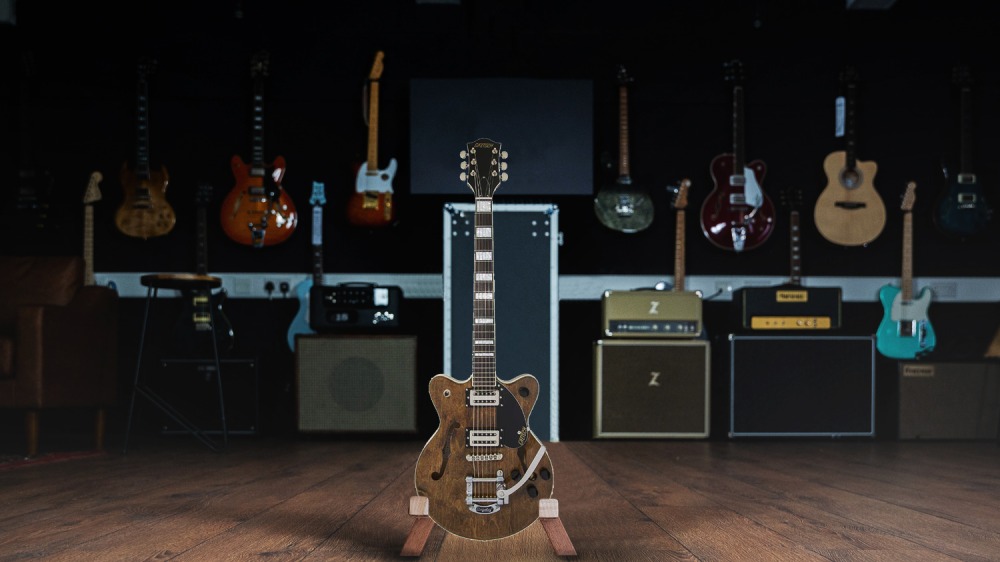
Gretsch guitars deliver a truly transformative experience when you play them. The model that I’m reviewing features a combination of archtop construction and wide-open sound that lets you play out of your comfort zone and allows you to be technically proficient.
First and foremost, you can get the Gretsch Streamliner is seven different models, starting from Center Block, Center Block Junior, and total hollow bodies.
The G2655T has a 24.75-inch scale length, so right off the bat, you can see that this jazz guitar has a relatively small size that feels comfortable, well-balanced and easy to play. On the other hand, getting into construction, the guitar boasts a semi-hollow body with a lightweight spruce center block that runs the length of its arched laminated maple body. Thus, if you combine these into one piece, it reinforces the top while contributing to eliminate feedback when you play at higher volumes.
In addition, the control layout is pretty traditional, it comes with neck and bridge volume controls, a master tone, three-way pickup selector and a master volume control located at the lower cutaway bout.
However, the most appealing feature out of all is the pair of Broad’Tron humbucking pickups that provide all the necessary high-output roar for players who want a powerhouse sound.
But that’s not all, as you can see, there’s really a lot that we can talk about this jazz guitar, such as the 12-inch fretboard radius, the super-slim U-profile neck shape, the 22 medium jumbo frets, and a Bigsby-licensed B50 vibrato tailpiece. What I also like about the Gretsch Streamliner is that it comes with classic Gretsch styling with Pearloid block inlays, F-holes, and two-ply white and black body binding.
When it comes to performance, just as you can imagine, the G2655T is really fun to play. The guitar comes all set-up out of the box, it comes with low action and the strings possessing a springy feel.
Before we end, I’d also like to point out that the Broad’Tron pickups are noticeably darker sounding with plenty of output, deep lows, growly midrange and cutting highs. So if you combine all of these into one piece, you’ll get a deliciously smooth sound when confronted with distortion.
Overall, we can’t quite call this jazz guitar a budget-friendly one, but we can definitely put it between affordable and mid-range. It comes with a reasonable price while it checks all the boxes of how a jazz guitar should perform and sound like.
3. D’Angelico Excel EXL-1
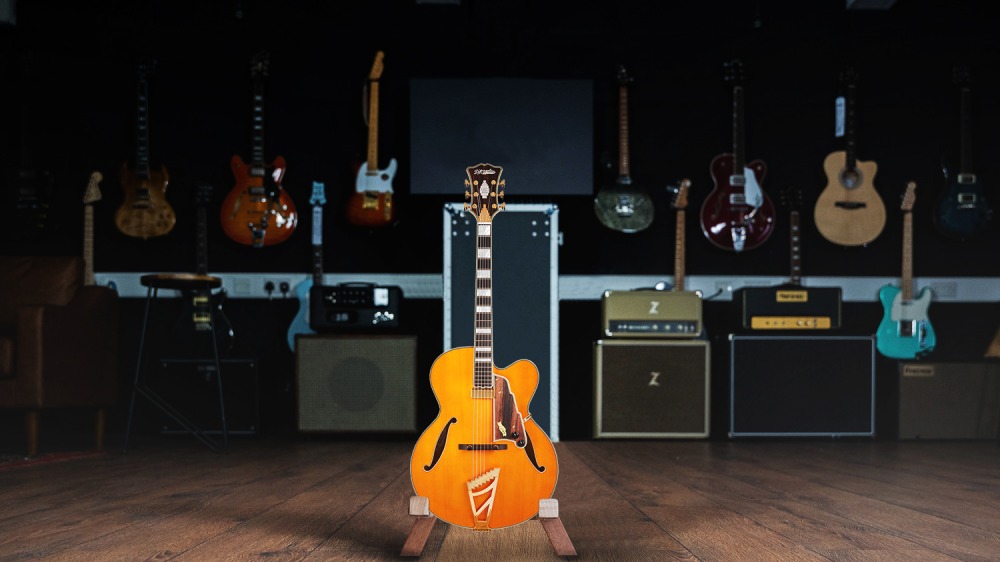
The D’Angelico Excel EXL-1 is also known as the best archtop guitar of the jazz age, and the maker of this jazz guitar John D’Angelico made approximately 1,164 archtops under his own name-, from 1932 until his death in 1964.
Based on Excel cutaway, this particular model features a big-body, a 432mm wide archtop with a side depth of 79.5mm. In practice, you’ll notice that the neck feels pretty old-school featuring a subtly asymmetric-feeling D profile.
To continue, the fretwork is tidy, but what got my attention is the specs. The manufacturer reports that the guitar is ebony, however, from what I’ve tested, the board itself is rosewood. Other than that, the headstock is huge, featuring 210mm in length from behind the cut bone nut to the open tip, and it includes the distinctive inset metal “finial”. Combining both the polished aluminum truss rod cover and the finial, these were inspired by NY’s skyline.
Performance-wise, most of you would think this was a very loud guitar as it is an acoustic archtop, however, it doesn’t quite reach a high volume level as you’d expect. Although that doesn’t mean that it won’t sound good, in fact, it outputs a characterful with an almost clipped and very direct tonality and short-ish yet sufficient sustain.
On the other hand, the midrange push cuts through when two jazz guitars are played at the same time. When you plug this guitar in, the EXL-1 produces a stately tonality, and even with the highest volumes, you’re still going to get too much crispness.
In my opinion, you’re going to get the most beautiful tonality when the volume is reduced and set to a decent amount. It’s important to note that there aren’t really many types of sound, but it’s still enough since you can go from older, darker jazz voices to more contemporary clarity.
To sum up, the D’Angelico Excel EXL-1 is definitely a must-have, it’s the most premium option that you will find if you’re looking for a guitar that is specifically made for jazz players, so you simply can’t go wrong with it. Definitely one of the best jazz guitars out there.
2. Ibanez AFV75 Artcore Hollowbody
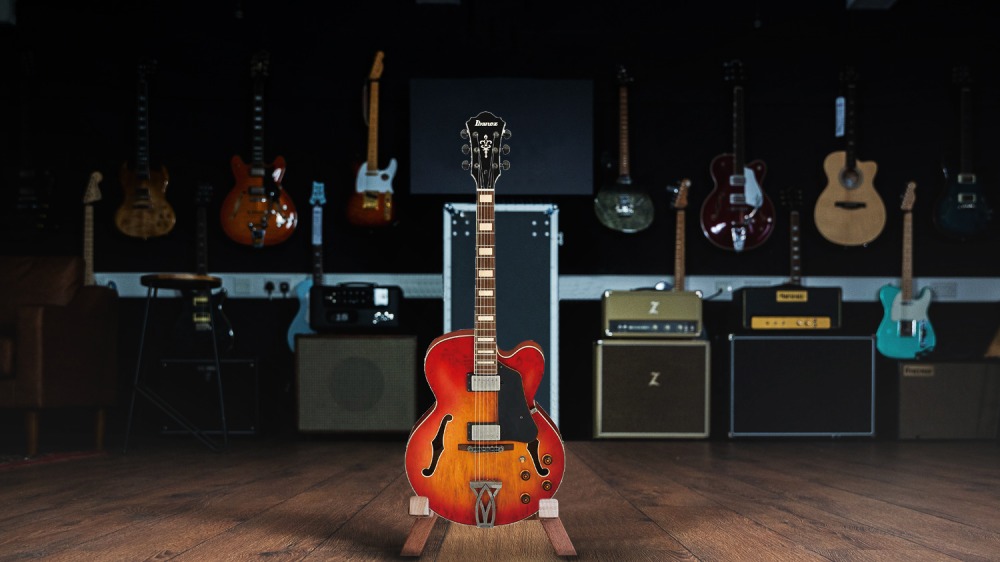
The next in our list is the Ibanez AFV75 Artcore Hollowbody. This particular guitar is one of my favorites, I’ve been using it for quite some time now, and it’s the most remarkable electric instrument that I’ve had. It combines a beautiful and unique design within one affordable package.
In terms of design, the Ibanez AFV75 Artcore Hollowbody features a linden body followed by a gorgeous satin finish. In addition, a pair of Classic Elite Humbuckers kick out killer humbucking tone, and an ART-I with VT60 Tailpiece makes a good job at providing outstanding sustain and tonal support.
Apart from that, what I also like about this guitar is the smooth nyatoh neck with laurel fingerboard which is as playable as it gets, and as responsive as it gets. All and all, that’s pretty much everything you could ever ask for in a jazz guitar, even more, it’s also suitable for blues and rock styles.
When it comes to performance, this fully hollowbody guitar comes an inch thinner than a standard hollowbody, which enables the guitar to produce more midrange and reducing boomy feedback. More on that, the pair of classic elite humbuckers along with a 3-way pickup selector and bridge and neck volume and tone controls will make sure to provide you with ample options for dialing in great tone.
This is exceptionally great for jazz, blues, and even rock players because the humbuckers are ideal for such genres, and they tend to deliver a full, warm humbucking sound.
As we move on, let’s also point out a couple of interesting facts about the neck. The nyatoh neck and laurel fingerboard on the AFV75 is incredible responsive and playable, whereas the 20 medium frets and 24.7″ scale length make chording and lean playing a breeze.
Before we end, let’s also mention that with the ART-I with VT60 Tailpiece, you can play for hours and enjoy every second of it due to the incredible sustain and tone support.
To finish up, the fully hollow body Ibanez Artcore would be your ideal choice if you’re looking for an electric guitar that produces stellar midrange tone.
1. Epiphone Joe Pass Emperor II

To round up our list, at number 1, we have the Epiphone Joe Pass Emperor II. The original maker of this guitar was Joe Pass, and he was called by many names, but the most popular one was the “president of bebop guitar”.
Joe saw the opportunity to make his own guitar, and he took it, but no one thought that this model would become so popular. It’s a stunning guitar that sits among the most premium ones on the market.
If you’ve used an Epiphone guitar before, then you probably know that all Epiphone jazz guitars come with Limited Lifetime Warranty, which basically shows the quality and the craftsmanship of this guitar.
In other terms, this guitar would be your ideal choice as it would be a one time purchase for a lifetime.
The Epiphone Joe Pass Emperor II is the signature guitar when it comes to jazz music, and it is being widely used by professional and famous guitarists out there. I am mentioning this because in my early phase of learning how to play the guitar, I used to think that if you use a guitar that a famous person does, then you’re most likely to learn more faster and become a talent.
Well, that pretty much turned out to be true, because in theory, a good guitar will definitely help you get better, and help you produce warm and joyful tones along the way.
That being said, I highly recommend this guitar for all jazz player skill-levels, and it’s pretty versatile so you simply can’t go wrong with it.
In terms of the design, this particular model features a classic hollow body archtop, and it combines a design of old but with two high-quality Brustbucker pickups, so that also means that it is suitable for a wide range of silky tones.
Moreover, the Epiphone Joes Pass Emperor II is not the best you can find, but it’s also not the worst. It’s in-between the midrange and affordable price range, and it truly delivers great value for money. As I mentioned, I’ve been personally using this guitar for quite some time, and I never recommend jazz guitars that I wouldn’t feel comfortable using.
Overall, you should truly take this guitar into serious consideration, and if you ever decide to purchase it, I assure that you will never regret your decision.
Frequently Asked Questions (FAQ)
How can I find the best amp for my jazz guitar?
Well firstly, if you care about looks, then you got plenty of options to choose from, as guitar amplifiers tend to come in a plethora of design starting from retro to futuristic. However, that's not really the important part of finding the best amp for your jazz guitar. What's important is the controls, and they should be as versatile as it gets, while the watt power is also important, and that's definitely something you should consider when buying one. Most jazz guitar amplifiers feature two 60-watt power amps that come connected to two individual 12
Can You Play Jazz Music With An Acoustic Guitar?
Of course, you can play Jazz music on an acoustic guitar, however, it won't sound as good. You can check out our recommendations for the best options for the Jazz genre.
Conclusion
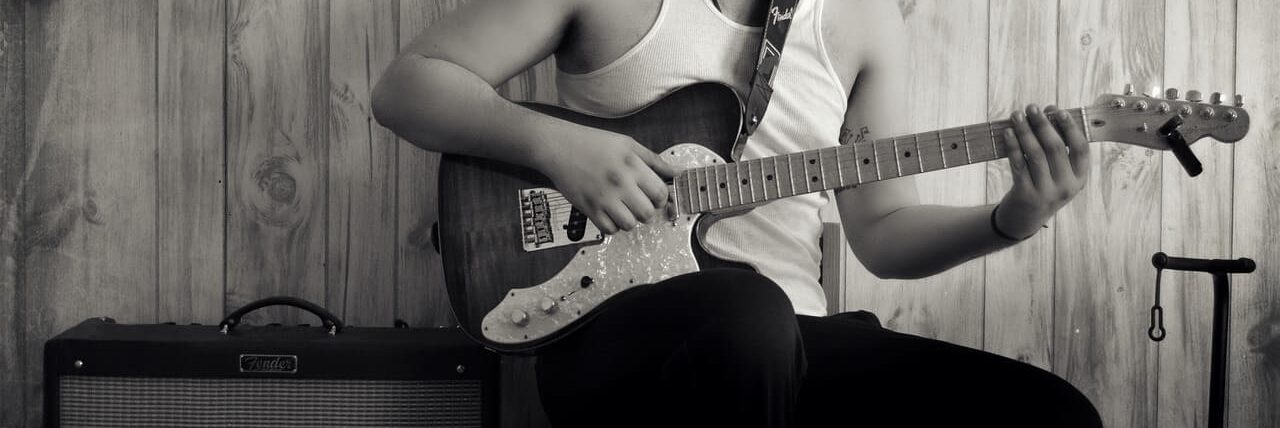
That’s pretty much everything you need to know about jazz guitars, as well as what amps to use for your jazz guitars whether for home use or outside.
As we got all of that out of the way, by now I believe you have efficient information on what to look for, what’s the best jazz guitar for you, and what meets your requirements the most.
I think I made it pretty much clear that there are a couple of factors that affect your decision when buying a jazz guitar, such as quality, performance, and more importantly price. Most of the jazz guitars out there tend to come at really hefty prices, but if you’re determined on what you want, I don’t think that would be a problem.
Nonetheless, in the list, I also put budget-friendly jazz guitars, because not everyone wants to spend a whole fortune on a guitar. Either way, all of them perform remarkably, and all of them are perfectly suited for jazz, blues, and even some rock ‘n roll styles.
I also included informative articles on jazz guitar amps, and that’s because, during my research, I noticed that a lot of people were struggling with finding the best amp’s for their jazz guitar. Everything that I mentioned above will serve you well when choosing your guitar amp, whether it’s for home use or other purposes. If you are a on a budget, i recommend checking out our article on the best jazz guitars under $1000.
I hope this article was helpful to you, and if you have any questions regarding this topic, make sure you contact me and I’ll get back to you as soon as possible.





